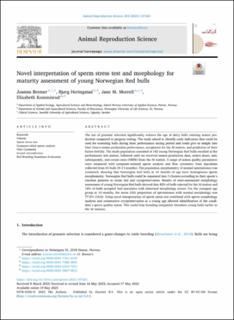Novel interpretation of sperm stress test and morphology for maturity assessment of young Norwegian Red bulls
Peer reviewed, Journal article
Published version
Permanent lenke
https://hdl.handle.net/11250/3115428Utgivelsesdato
2023Metadata
Vis full innførselSamlinger
Originalversjon
10.1016/j.anireprosci.2023.107261Sammendrag
The use of genomic selection significantly reduces the age of dairy bulls entering semen production compared to progeny testing. The study aimed to identify early indicators that could be used for screening bulls during their performance testing period and could give us insight into their future semen production performance, acceptance for the AI station, and prediction of their future fertility. The study population consisted of 142 young Norwegian Red bulls enrolled at the performance test station, followed until we received semen production data, semen doses, and, subsequently, non-return rates (NR56) from the AI station. A range of semen quality parameters were measured with computer-assisted sperm analysis and flow cytometry from ejaculates collected from 65 bulls (9–13 months). The population morphometry of normal spermatozoa was examined, showing that Norwegian Red bulls at 10 months of age have homogenous sperm morphometry. Norwegian Red bulls could be separated into 3 clusters according to their sperm's reaction patterns to stress test and cryopreservation. Results of semi-automated morphology assessment of young Norwegian Red bulls showed that 42% of bulls rejected for the AI station and 18% of bulls accepted had ejaculates with abnormal morphology scores. For the youngest age group at 10 months, the mean (SD) proportion of spermatozoa with normal morphology was 77.5% (10.6). Using novel interpretation of sperm stress test combined with sperm morphology analysis and consecutive cryopreservation at a young age allowed identification of the candidate's sperm quality status. This could help breeding companies introduce young bulls earlier to the AI stations.

